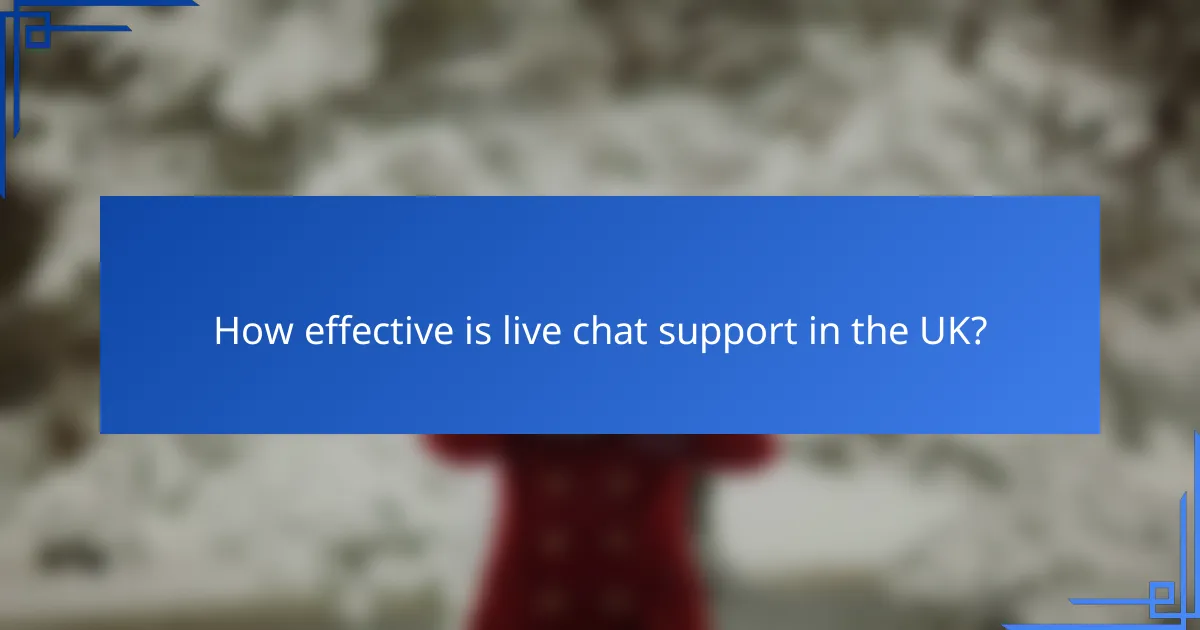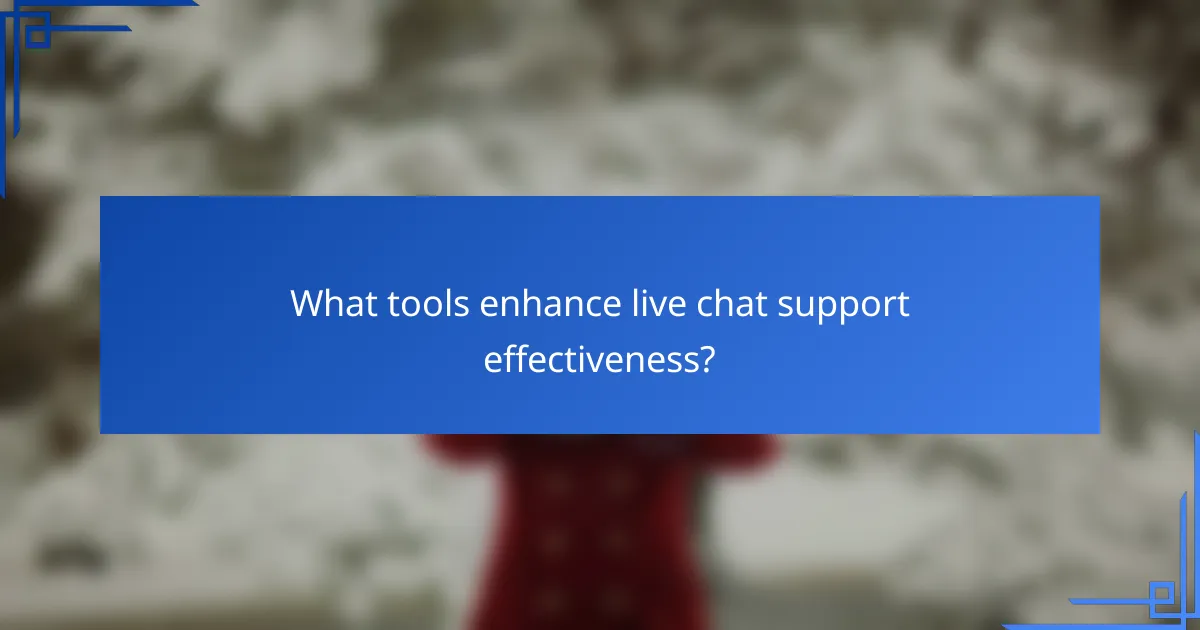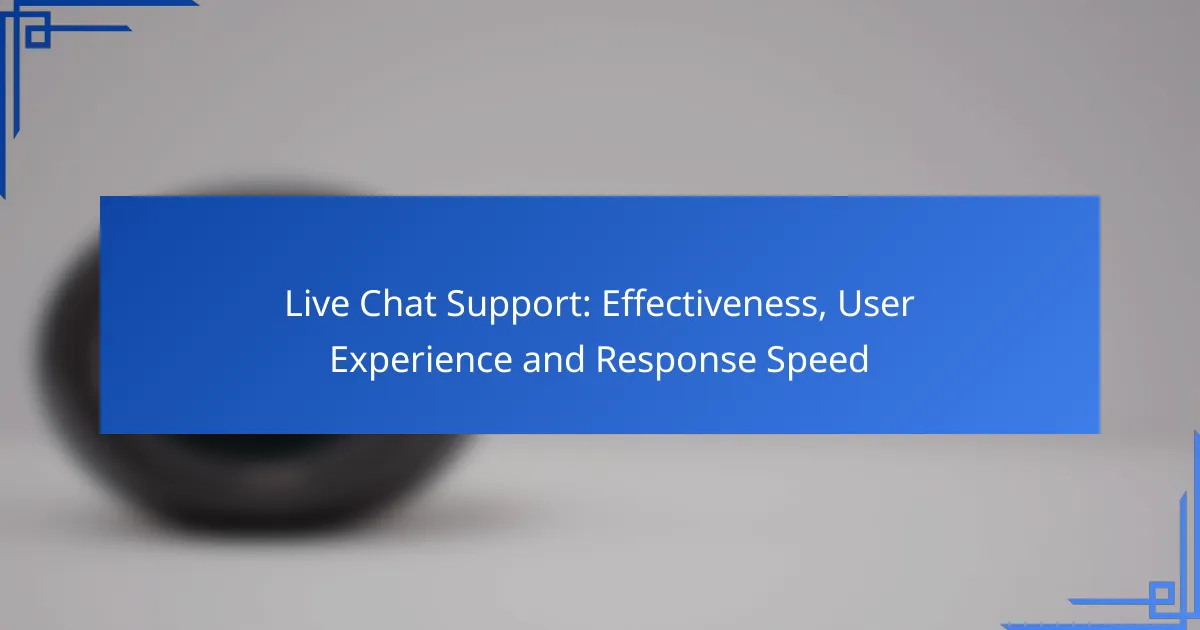Live chat support has emerged as a highly effective tool for businesses in the UK, offering immediate assistance that enhances customer engagement. This interactive communication method allows for quick resolution of inquiries, significantly improving customer satisfaction and retention rates. The speed of response is crucial, as timely replies contribute to a positive user experience, while delays can lead to frustration and dissatisfaction.

How effective is live chat support in the UK?
Live chat support is highly effective in the UK, providing immediate assistance and enhancing customer engagement. It allows businesses to address inquiries quickly, leading to improved satisfaction and retention rates.
High customer satisfaction rates
Live chat support often results in high customer satisfaction rates, as it offers real-time interaction. Customers appreciate the convenience of getting instant answers without waiting on hold or navigating complex phone menus.
Research indicates that many users prefer live chat over other support channels, with satisfaction rates frequently exceeding 80%. This preference stems from the efficiency and accessibility that live chat provides, especially for quick queries.
Increased conversion rates
Implementing live chat can significantly boost conversion rates for businesses. By providing immediate assistance, companies can guide potential customers through the purchasing process, addressing concerns that may otherwise lead to cart abandonment.
Studies show that businesses utilizing live chat often see conversion increases in the range of 20-30%. This increase is attributed to the personalized support that helps customers feel more confident in their purchasing decisions.
Reduced response times
Live chat support dramatically reduces response times compared to traditional methods. Customers typically receive answers within seconds, which is crucial for maintaining engagement and satisfaction.
In the UK, average response times for live chat can be as low as 10-30 seconds, significantly faster than email or phone support. This quick turnaround can be a decisive factor for customers seeking immediate assistance.

What is the user experience of live chat support?
The user experience of live chat support is generally characterized by immediate assistance and interactive communication. Customers appreciate the convenience and speed of resolving issues without the need for phone calls or emails.
Real-time communication benefits
Real-time communication in live chat support allows users to receive instant responses, significantly reducing wait times compared to traditional support methods. This immediacy enhances customer satisfaction as users can quickly address their concerns or questions.
Moreover, live chat can handle multiple inquiries simultaneously, which means that support agents can assist several customers at once, improving overall efficiency. This is particularly beneficial for businesses during peak hours when demand is high.
Accessibility for diverse users
Live chat support is accessible to a wide range of users, including those with disabilities who may find traditional communication methods challenging. Features like text-to-speech and screen readers can enhance usability for visually impaired individuals.
Additionally, live chat can be available in multiple languages, catering to a diverse customer base. This inclusivity helps businesses reach a broader audience and improves user experience across different demographics.
Integration with existing systems
Integrating live chat support with existing customer relationship management (CRM) systems can streamline operations and improve data management. This integration allows agents to access customer history and preferences, enabling personalized support.
Furthermore, businesses can utilize chatbots alongside live agents to handle routine inquiries, freeing up human resources for more complex issues. This hybrid approach can enhance efficiency while maintaining a high level of customer service.

How does response speed impact customer satisfaction?
Response speed significantly influences customer satisfaction, as quicker replies often lead to a more positive experience. Customers expect timely assistance, and delays can result in frustration and dissatisfaction.
Immediate assistance leads to higher satisfaction
When customers receive immediate assistance, their overall satisfaction tends to increase. Quick responses demonstrate that a company values its customers and prioritizes their needs. For instance, a response time of under a minute can elevate the customer’s perception of service quality.
To enhance immediate assistance, businesses should implement live chat support that is readily available during peak hours. This ensures that customers can reach out and receive help without long wait times, fostering a sense of reliability.
Correlation between speed and retention
There is a strong correlation between response speed and customer retention rates. Faster response times can lead to higher loyalty, as customers are more likely to return to a brand that addresses their inquiries promptly. Studies suggest that companies with response times under five minutes can see retention rates increase by significant margins.
To leverage this correlation, businesses should regularly monitor and optimize their response times. Implementing chatbots for initial inquiries can help manage volume and ensure that human agents are available for more complex issues, striking a balance between speed and quality of service.

What are the best practices for implementing live chat support?
To implement effective live chat support, focus on training staff, utilizing chatbots, and setting clear response time expectations. These practices enhance user experience and ensure timely assistance, leading to higher customer satisfaction.
Training staff for effective communication
Training staff in effective communication is crucial for live chat support. Representatives should be equipped with skills to engage customers clearly and empathetically, addressing their concerns promptly. Regular training sessions can help staff stay updated on product knowledge and communication techniques.
Consider role-playing scenarios to simulate real customer interactions. This practice can improve response quality and build confidence among team members. Encourage staff to use positive language and active listening to foster a supportive environment.
Utilizing chatbots for initial queries
Chatbots can efficiently handle initial queries, allowing human agents to focus on more complex issues. By programming chatbots to answer frequently asked questions, businesses can reduce wait times and improve overall response efficiency. This setup is particularly beneficial during peak hours.
Ensure that chatbots are designed to recognize when to escalate issues to human agents. This balance helps maintain a seamless user experience while providing quick answers to common inquiries.
Setting clear response time expectations
Setting clear response time expectations is vital for managing customer satisfaction. Inform users about typical wait times at the start of a chat, which can range from a few seconds to a couple of minutes, depending on the volume of inquiries. Transparency helps reduce frustration and builds trust.
Consider implementing a system that updates users on their position in the queue or estimated wait times. This proactive approach can enhance the user experience and encourage patience during busy periods.

What tools enhance live chat support effectiveness?
Several tools can significantly enhance the effectiveness of live chat support by streamlining communication, personalizing interactions, and integrating with existing systems. Utilizing the right software can lead to improved response times and a better overall user experience.
Zendesk for customer service management
Zendesk is a comprehensive customer service platform that offers live chat capabilities alongside ticketing and support management. It allows businesses to track customer interactions and manage inquiries efficiently, ensuring that no message goes unanswered.
Key features include automated responses, reporting tools, and integration with other Zendesk products. This helps teams maintain consistency in customer service and provides valuable insights into performance metrics.
Intercom for personalized messaging
Intercom specializes in personalized messaging, allowing businesses to tailor their communication based on user behavior and preferences. This tool uses targeted messages to engage customers at critical touchpoints, increasing the likelihood of conversion.
With features like chatbots and proactive messaging, Intercom enhances user experience by providing timely assistance. Businesses can segment their audience for more effective outreach, ensuring that messages resonate with specific user needs.
LiveChat for seamless integration
LiveChat is designed for seamless integration with various platforms, including CRM systems and e-commerce solutions. This flexibility allows businesses to maintain a unified approach to customer interactions across multiple channels.
Its user-friendly interface and robust analytics tools enable teams to monitor chat performance and customer satisfaction. By integrating LiveChat with existing tools, companies can streamline workflows and enhance response efficiency.

What are the challenges of live chat support?
Live chat support faces several challenges that can impact its effectiveness, including managing high volumes of inquiries and ensuring consistent quality of responses. Addressing these issues is crucial for maintaining user satisfaction and operational efficiency.
Managing high volumes of inquiries
Handling a large number of inquiries simultaneously can overwhelm support teams, leading to longer wait times and decreased customer satisfaction. It is essential to implement strategies such as prioritizing urgent requests and utilizing chatbots for initial interactions to manage this influx effectively.
Consider using a tiered support system where complex issues are escalated to human agents while simpler queries are resolved through automated responses. This approach can help maintain response speed and reduce the burden on live agents.
Ensuring consistent quality of responses
Maintaining a high standard of response quality is vital for live chat support. Inconsistent answers can frustrate customers and damage the brand’s reputation. Regular training sessions for support staff and the use of standardized response templates can help ensure that all agents provide accurate and helpful information.
Additionally, implementing a feedback loop where customers can rate their chat experience can provide valuable insights into areas needing improvement. Monitoring chat transcripts for quality assurance can also help identify common pitfalls and enhance overall service delivery.

How do user demographics affect live chat preferences?
User demographics significantly influence live chat preferences, including response expectations and communication styles. Factors such as age, location, and technological proficiency can shape how different groups engage with live chat support.
Age and Communication Style
Younger users, typically more familiar with digital communication, may prefer quick, informal interactions through live chat. In contrast, older demographics might favor more structured conversations, valuing clarity and detail over speed.
For example, millennials and Gen Z users often expect instant responses and may use emojis or shorthand, while baby boomers might appreciate a more formal tone and comprehensive explanations. Understanding these preferences can help businesses tailor their chat strategies effectively.
Geographic Location
Geographic location affects not only language preferences but also cultural norms around communication. Users from different regions may have varying expectations regarding response times and the formality of interactions.
For instance, customers in Western countries might expect faster responses, often within a few minutes, while those in other regions may be more accustomed to longer wait times. Businesses should consider local customs and time zones when setting up their live chat support.
Technological Proficiency
The level of technological proficiency among users can greatly impact their live chat experience. More tech-savvy individuals may prefer advanced features like chatbots or multimedia sharing, while less experienced users might struggle with complex interfaces.
To cater to a diverse audience, companies should ensure their live chat systems are user-friendly and provide clear guidance for those who may need assistance. Offering tutorials or FAQs can help bridge the gap for users with varying levels of comfort with technology.
